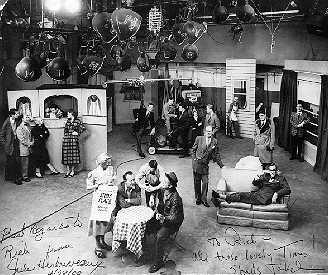|
The Chicago School of Television
Curator's
Note: The photograph below (shot in studio
A) comes as close as a single image can to illustrating a complex concept---in
this case, what the first generation of television critics called, always with
affection, the "The Chicago School of Television". It appeared in the
March 27th, 1951 edition of Look Magazine with the following caption:
| "It's
been called relaxed, intimate, friendly, natural, subtle---but the main thing
about the "Chicago School" of TV, more widely copied in higher-priced,
higher-pressured areas, is this: The viewer doesn't always know what's going to
happen next and next and next. |
This page will serve
as an introduction to the 'Chicago School' and its practitioners. (Perhaps you
should first read Arch Oboler's essay 'Windy
Kilocycles'. He convincingly argues that Chicago's creative approach to television
was a continuation of the city's innovative approach to radio). |
 |
The
above photo shows Burr Tillstrom and
Fran Allison of Kukla, Fran and Ollie; Beverly Younger, Chet Roble, Studs
Terkel and Win Stracke of Stud's Place; Dave
Garroway of Garroway
at Large; comedian Cliff Norton ( a Garroway regular and, for a
time, star of his daily show, The Public Life of Cliff Norton), Walt Durhban
(of Walt's Workshop) and (in the overcoat) Clint Youle, the archetype of
the television weatherman.
This picture also shows the man---standing, with his left hand resting on the
couch--- generally credited with creating the "Chicago School". He is
surrounded by the performers (and some of the production people) who exemplified
this unique brand television on the air.
Jules Herbuveaux,
charged with putting NBC's Chicago owned-and-operated station on the air, was
the first general manager of WNBQ (the predecessor call-letters of today's WMAQ-TV).
His tasks included the generation of local programming and development of shows
for the NBC network which, not long after WNBQ took to the air, was extended west
as far as Saint Louis.
Herbuveaux had a remarkable eye for talent appropriate to the new video medium.
The personalities he put on the air, and the programs they were part of, defined
television as a unique, pure medium of its own. It was not theater. It was not
film. It was television, plain and simple.
[Jules Herbuveaux
autographed this photo on the occasion of a 1989 interview. Studs Terkel autographed
it in October, 1995. Studs and I work in the same building. Studs works for WFMT.
I work for WTTW. Stud's latest book is Coming of Age.]
This page
will include links to text and graphics document that illustrate the development
(and the decline) of the "Chicago School". The curator's resources in
this area are vast. So have patience. |
Currently
available...
Comments
or suggestions? click
here to send them to Rich Samuels
Created by
Rich Samuels (e-mail to rich@richsamuels.com)
|